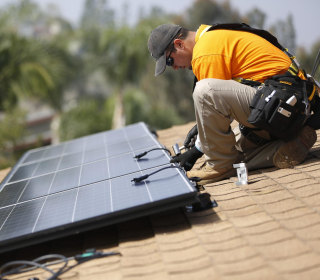This could be a significant economic shift. Our cities are full of inefficient buildings that suck the life out of the people living in them. Utility costs go up and bite harder into their budgets. Every dollar taken out of those budgets from health and education cripples society. There's been a big push on a state level to get these home efficient. Fixing most of their future electrical costs with renewables will make their operating costs much more affordable...and will bring a cleaner environment around them.

The Obama administration is starting a new program designed to spread solar power and solar industry jobs to a wider range of Americans, including renters and low-income communities, according to a White House announcement Tuesday. The program includes a commitment to install 300 megawatts of new solar panels on federally subsidized housing by 2020, and to offer loans and "toolkits" that will make it easier for low-income Americans to draw their energy from solar power and improve energy efficiency in their homes.
Officials on a conference call with reporters Tuesday did not provide an estimate of the program's cost. To put 300 MW of solar energy in perspective, the Solar Energy Industries Association estimates that 1 MW of energy can power about 164 homes. Actual results can vary depending on how much sunshine a region receives and how much energy homes use, and other factors. The White House said that state and local governments, NGOs and companies have promised $520 million to increase solar power use and energy efficiency programs around the country, and that housing authorities and utilities will start 260 solar power projects across 20 states.
The president wants to create 75,000 solar industry jobs by 2020 as well, and plans to use AmeriCorps funding to train workers for solar jobs, according to the White house announcement. Solar power continues to be an attractive renewable energy sector for consumers. Prices of solar panels and other equipment remain low, and some expect that to continue. Customers who can draw at least part of their energy from solar power can potentially save a lot of money on power bills, but first they need the roof space and the money to install solar panels.
The worst may be over for crude oil: Strategist For that reason, homeowners are among the biggest customers of solar power—they have the roof space for the panels, and, because they own their homes, the authority to install them. Renters, on the other hand, have to seek permission from landlords—who may not grant it—and apartment dwellers have the added complication of living in multiunit buildings. Many lower-income Americans are renters who live in apartments or subsidized housing.
Some companies already offer financing for solar power systems, and some communities allow customers to draw their energy from wind or solar farms that may be located far away from end users. But electricity costs remain a burden for many low-income customers, said U.S. Rep. Elijah Cummings, D-Md., on Tuesday's conference call. Motorcycle or car? Toyota's electric 3-wheeler "We all know that underserved communities struggle to pay their bills—I lived in an underserved community so I'm very familiar," Cummings said. "But I cannot tell you the number of calls I get in my office from constituents who have to make choices about which bills they will pay each month, and those choices could mean having their electricity cut off."
President Obama and Brazilian President Dilma Rousseff jointly pledged last week to increase renewable energy use (excluding hydropower) to 20 percent of the total energy mix for both countries by 2030. "Achieving that goal of renewable deployment across our electricity grid means we basically have to triple where we are, starting today," said Brian Deese, senior advisor to Obama.

No comments:
Post a Comment